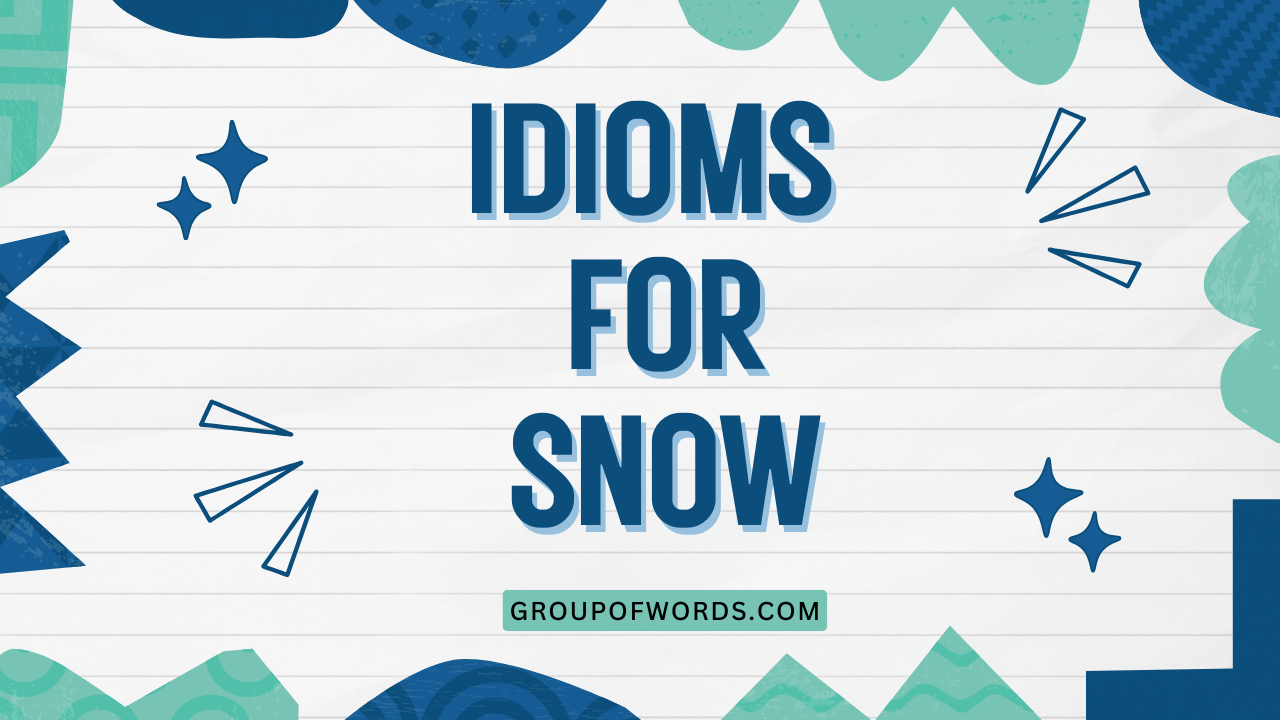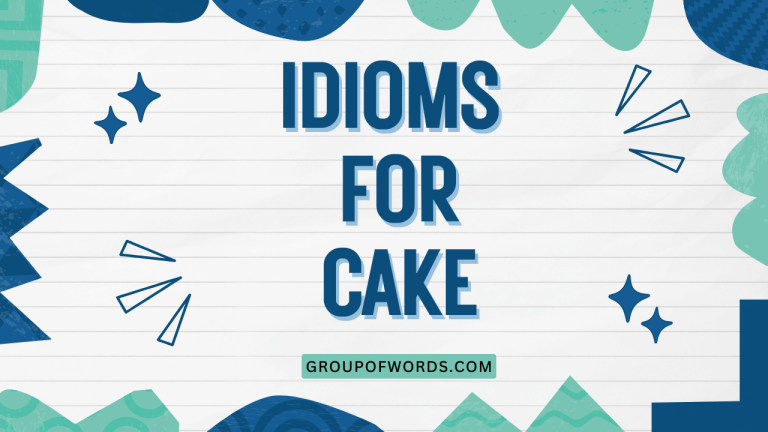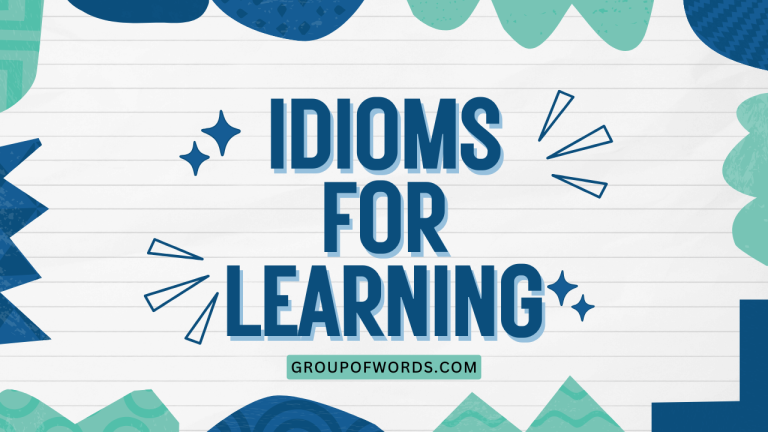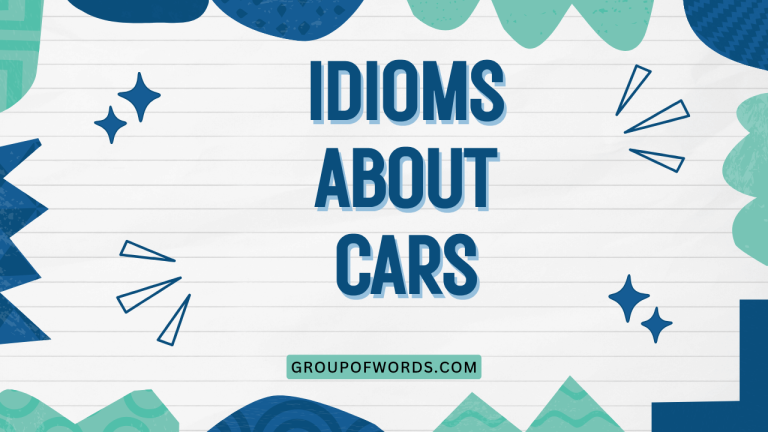Snow Idioms: Mastering Figurative Language in English
Understanding idioms is crucial for mastering the nuances of the English language. Idioms are phrases whose meanings cannot be understood from the literal definitions of the individual words.
Snow idioms, in particular, offer a fascinating glimpse into how English speakers use the imagery of snow to convey various concepts and emotions. This article will explore a wide range of snow-related idioms, providing definitions, examples, and practical exercises to help you confidently incorporate them into your everyday communication.
Whether you’re an ESL learner or a native speaker looking to expand your linguistic repertoire, this comprehensive guide will deepen your understanding and appreciation of English idioms.
Table of Contents
- Introduction
- What are Snow Idioms?
- Structural Breakdown of Snow Idioms
- Types and Categories of Snow Idioms
- Examples of Snow Idioms
- Usage Rules for Snow Idioms
- Common Mistakes with Snow Idioms
- Practice Exercises
- Advanced Topics in Snow Idioms
- Frequently Asked Questions
- Conclusion
Introduction
Idioms are an integral part of the English language, adding color and depth to everyday conversations and written texts. Snow idioms, drawn from the imagery of winter weather, are particularly evocative.
These phrases often carry meanings far removed from their literal interpretations, allowing speakers to express complex ideas in a concise and memorable way. Understanding and using snow idioms effectively can significantly enhance your communication skills, making you sound more natural and fluent.
This article serves as a comprehensive guide, providing definitions, examples, and practice to help you master these fascinating expressions.
What are Snow Idioms?
Snow idioms are figurative expressions that use the imagery of snow, ice, and winter to convey a meaning that is different from the literal definitions of the words used. These idioms rely on shared cultural understandings and associations with snow, such as coldness, purity, or the potential for accumulation and impact.
They are a type of fixed expression, meaning their form is generally set and cannot be altered without losing their idiomatic meaning. Snow idioms function as a way to add emphasis, humor, or nuance to communication, making it more engaging and relatable.
They are commonly used in both spoken and written English, adding richness and depth to the language.
Structural Breakdown of Snow Idioms
Snow idioms, like all idioms, are phrases with a fixed structure. Their grammatical composition can vary, encompassing noun phrases, verb phrases, and even complete clauses.
The key characteristic is that the meaning is not compositional, meaning it cannot be derived by simply adding up the meanings of the individual words. Understanding the structural elements of snow idioms can help in recognizing and interpreting them correctly.
The idioms often contain common grammatical structures, but the specific words related to snow (e.g., snow, ice, blizzard) are crucial for triggering the figurative meaning.
For instance, an idiom like “snowed under” uses a past participle after a verb (“to be”) to describe a state of being overwhelmed. “Snowball effect” uses a noun (“snowball”) as a modifier to another noun (“effect”) to describe a phenomenon of increasing momentum.
Recognizing these structural patterns can aid in comprehending and utilizing snow idioms effectively in different contexts.
Types and Categories of Snow Idioms
Snow idioms can be categorized based on the specific aspect of snow or winter they evoke and the meaning they convey. Here are some common categories:
Idioms Related to Overwhelm
These idioms often use the image of heavy snowfall to represent being burdened or overwhelmed with tasks, responsibilities, or information. Examples include “snowed under” and variations thereof.
Idioms Related to Growth or Momentum
These idioms use the image of a snowball rolling down a hill to represent something that starts small but rapidly increases in size or impact. The prime example is “snowball effect.”
Idioms Related to Hidden Problems
These idioms use the image of an iceberg, where only a small portion is visible above the water, to represent a larger, hidden problem or issue. The most common example is “tip of the iceberg.”
Idioms Related to Purity or Innocence
These idioms connect the whiteness and perceived cleanliness of snow with qualities of purity, innocence, or naivety. An example is “pure as the driven snow.”
Idioms Related to Coldness or Lack of Emotion
These idioms use the coldness of snow and ice to represent a lack of warmth, empathy, or emotion. An example is “cold as ice.”
Idioms Related to Starting a Conversation or Relationship
These idioms use the image of breaking ice to represent initiating a conversation or easing tension in a social situation. The most common example is “break the ice.”
Examples of Snow Idioms
This section provides detailed examples of common snow idioms, categorized by their central theme. Each idiom is explained with a clear definition and multiple examples illustrating its usage in different contexts.
Understanding these examples will help you grasp the nuances of each idiom and use them correctly.
Snowed Under
Definition: To be overwhelmed with a large amount of work or responsibilities.
The idiom “snowed under” evokes the image of being buried beneath a heavy snowfall, unable to cope with the sheer volume. It is commonly used to describe feeling stressed and overburdened with tasks or obligations.
The following table provides examples of how “snowed under” is used in various sentences:
| Example | Explanation |
|---|---|
| I’m completely snowed under with work this week. | The speaker is extremely busy and has too much work to handle. |
| She’s been snowed under with emails since returning from vacation. | She has received a large number of emails and is struggling to manage them. |
| The team is snowed under with customer requests. | The team is receiving more customer requests than they can handle. |
| He felt snowed under by the pressure of the upcoming deadline. | He felt overwhelmed by the impending deadline and the work required to meet it. |
| With the holidays approaching, I’m snowed under with preparations. | The speaker is busy preparing for the holidays and has many tasks to complete. |
| The small business was snowed under with orders after their product went viral. | The business received an overwhelming number of orders following increased popularity. |
| As the project manager, she was snowed under with paperwork and meetings. | The project manager was burdened with a large amount of administrative tasks. |
| The teacher was snowed under with grading papers and preparing lesson plans. | The teacher had a significant amount of grading and planning to do. |
| I can’t go out tonight; I’m completely snowed under. | The speaker is too busy to socialize due to being overwhelmed with tasks. |
| Our customer service department is snowed under during the holiday season. | The customer service department experiences a high volume of inquiries during the holidays. |
| The hospital staff were snowed under with patients during the flu epidemic. | The hospital staff were overwhelmed with the number of patients during a widespread illness. |
| He was snowed under with applications after posting the job opening. | He received a large number of job applications that he needed to review. |
| The IT department is snowed under with requests for technical support. | The IT department is receiving more support requests than they can handle. |
| She felt snowed under by the demands of her new job. | She felt overwhelmed by the responsibilities and expectations of her new position. |
| We’re snowed under getting ready for the conference next week. | The speaker and their team are very busy preparing for an upcoming conference. |
| The marketing team was snowed under with campaign launches and analysis reports. | The marketing team had a lot of campaigns to start and reports to make. |
| The legal team is snowed under with contract reviews and compliance checks. | The legal team has many contracts to examine and compliance issues to monitor. |
| The research team was snowed under with data analysis and publication writing. | The research team had a lot of data to analyze and papers to write. |
| The logistics department is snowed under with shipments and inventory management. | The logistics department is struggling to handle the volume of shipments and inventory. |
| The accounting department was snowed under with tax season preparations. | The accounting department was extremely busy preparing for tax season. |
| With the new product release, the engineering team is snowed under with debugging and testing. | The engineering team is busy resolving issues and testing the new product. |
| The human resources department is snowed under with recruitment and onboarding new employees. | The HR department has a large workload of hiring and training new staff. |
| The editorial team was snowed under with manuscripts to review and edit. | The editorial team was overwhelmed with the amount of reviewing and editing they needed to do. |
Snowball Effect
Definition: A situation in which an initial event or decision has a gradually increasing impact or significance.
The idiom “snowball effect” describes how something small can grow into something much larger and more significant over time, similar to how a snowball gathers more snow as it rolls downhill. It’s used to illustrate a chain reaction or escalating situation.
The table below provides examples of how “snowball effect” is used in various sentences:
| Example | Explanation |
|---|---|
| The company’s initial success created a snowball effect, leading to rapid expansion. | The company’s early success contributed to its fast growth. |
| A small mistake can have a snowball effect, resulting in significant problems later on. | A minor error can lead to bigger issues if not addressed promptly. |
| The positive feedback created a snowball effect, boosting team morale. | The good feedback led to an increase in team spirit. |
| The economic crisis had a snowball effect on businesses worldwide. | The financial crisis caused widespread problems for companies globally. |
| Her good deed had a snowball effect, inspiring others to volunteer. | Her act of kindness encouraged more people to help out. |
| The rumor spread through the office with a snowball effect. | The rumor rapidly gained traction and spread widely. |
| Increased investment in research can have a snowball effect on innovation. | More funding leads to increased innovation. |
| The social media campaign experienced a snowball effect after a celebrity endorsement. | The campaign’s reach expanded rapidly after the celebrity’s support. |
| The decline in customer satisfaction had a snowball effect on sales. | Lower satisfaction led to decreasing sales. |
| The new policy had a snowball effect on employee productivity. | The policy significantly impacted employee productivity. |
| The popularity of the app experienced a snowball effect after its launch. | The app quickly gained popularity. |
| The reduction in interest rates had a snowball effect on housing prices. | Lower interest rates significantly impacted housing costs. |
| The small act of kindness had a snowball effect, improving community relations. | A simple gesture significantly improved the community’s harmony. |
| The initial software bug had a snowball effect, causing major system failures. | The bug led to widespread system problems. |
| The marketing strategy produced a snowball effect, increasing brand awareness. | The marketing significantly boosted brand awareness. |
| The initial investment in renewable energy had a snowball effect on environmental conservation. | Investing in renewable energy significantly helped the environment. |
| The small delay in the project had a snowball effect, pushing back the deadline significantly. | A minor delay led to a much bigger delay in the project’s completion. |
| The initial cost savings from the new technology had a snowball effect on the company’s profits. | The money saved by the new technology greatly increased the company’s profits. |
| The negative publicity had a snowball effect, damaging the company’s reputation. | The bad press rapidly hurt the company’s image. |
| The implementation of lean manufacturing had a snowball effect on efficiency. | Using lean manufacturing significantly increased efficiency. |
| The viral video had a snowball effect on the artist’s career. | The video rapidly advanced the artist’s career. |
| The small increase in unemployment had a snowball effect on the local economy. | The slightly higher unemployment rate significantly affected the economy. |
| The collaborative approach had a snowball effect on team effectiveness. | Working together significantly improved the team’s performance. |
Tip of the Iceberg
Definition: Only a small, visible part of a much larger, hidden problem.
The “tip of the iceberg” idiom uses the image of an iceberg, where the majority of its mass is submerged underwater, to illustrate that what is visible is only a small portion of a much larger, underlying issue. This idiom is used to highlight the presence of hidden complexities or problems that may be much more significant than they initially appear.
The following table provides examples of how “tip of the iceberg” is used in various sentences:
| Example | Explanation |
|---|---|
| The financial issues we’re seeing are just the tip of the iceberg. | The current financial problems are indicative of larger, underlying issues. |
| The reported cases of the disease are likely just the tip of the iceberg. | The number of reported cases is probably much lower than the actual number of cases. |
| The customer complaints are the tip of the iceberg; many others are likely dissatisfied. | The complaints received are only a small representation of the total number of unhappy customers. |
| The environmental damage we’ve observed is just the tip of the iceberg. | The visible environmental harm is only a small part of a much larger problem. |
| The challenges we’ve faced so far are just the tip of the iceberg compared to what’s coming. | The difficulties encountered so far are minor compared to future challenges. |
| The security breach was just the tip of the iceberg, revealing deeper vulnerabilities in the system. | The breach exposed larger, more fundamental security flaws. |
| The ethical concerns raised are the tip of the iceberg, pointing to systemic issues within the organization. | The raised concerns are a sign of deeper, more widespread problems. |
| The performance issues we’re addressing are just the tip of the iceberg, with fundamental changes needed. | The performance problems are a small part of needed fundamental changes. |
| The data discrepancies are just the tip of the iceberg, suggesting broader data integrity problems. | The data discrepancies are a sign of larger data integrity issues. |
| The reported incidents are the tip of the iceberg, with many cases going unreported. | The reported incidents are only a fraction of the total number of incidents. |
| The surface-level improvements are just the tip of the iceberg, with deeper structural reforms needed. | The visible improvements are a small part of much bigger structural reforms. |
| The budget cuts are the tip of the iceberg, with more significant financial constraints on the horizon. | The budget cuts are a sign of more financial problems to come. |
| The visible symptoms are just the tip of the iceberg, with underlying health issues needing investigation. | The visible symptoms are a sign of deeper health problems. |
| The identified risks are the tip of the iceberg, with more hidden threats needing assessment. | The identified risks are just a small part of hidden threats. |
| The training programs are just the tip of the iceberg, with a need for broader skill development initiatives. | The training programs are just a small part of wider skill development. |
| The operational inefficiencies are just the tip of the iceberg, with need for process redesign. | The operational inefficiencies are a sign of needed process redesign. |
| The visible pollution is just the tip of the iceberg, indicating larger environmental degradation. | The pollution is a sign of environmental degradation. |
| The reported errors are just the tip of the iceberg, with many mistakes undiscovered. | The reported errors are just a small part of undiscovered mistakes. |
| The compliance violations are the tip of the iceberg, suggesting a broader lack of adherence to regulations. | The compliance violations are a sign of a lack of adherence to regulations. |
| The superficial changes are just the tip of the iceberg, with deeper cultural shifts needed. | The changes are just a small part of cultural shifts. |
| The visible problems are just the tip of the iceberg, with underlying systemic issues requiring fundamental reform. | The problems are just a small part of systemic issues. |
| The initial findings are the tip of the iceberg, with further investigation needed to uncover the full scope. | The findings are a sign of what is to come. |
| The reported incidents of harassment are just the tip of the iceberg, indicating a pervasive toxic culture. | The harassment is a sign of a toxic culture. |
Pure as the Driven Snow
Definition: Completely innocent or virtuous.
The idiom “pure as the driven snow” uses the image of freshly fallen, untouched snow to represent innocence, purity, and virtue. This idiom is often used ironically or sarcastically to describe someone who is perceived as naive or overly innocent.
The following table provides examples of how “pure as the driven snow” is used in various sentences:
| Example | Explanation |
|---|---|
| She acts like she’s pure as the driven snow, but I know she’s hiding something. | The speaker doesn’t believe the person is as innocent as they appear. |
| He claimed he was pure as the driven snow, but his past tells a different story. | His past actions contradict his claim of innocence. |
| The politician tried to portray himself as pure as the driven snow, but the media exposed his scandals. | The politician’s claimed innocence was undermined by revelations of misconduct. |
| She always presents herself as pure as the driven snow, but she’s actually quite cunning. | Her outward appearance of innocence is a facade. |
| He may seem pure as the driven snow, but don’t underestimate his intelligence. | His innocent appearance shouldn’t be mistaken for a lack of intelligence. |
| The con artist acted pure as the driven snow to gain the trust of his victims. | The con artist feigned innocence to deceive people. |
| Despite the rumors, she maintained that she was pure as the driven snow. | She consistently denied the rumors and claimed innocence. |
| He tried to convince the jury that he was pure as the driven snow, but the evidence was against him. | He attempted to present himself as innocent, but the evidence suggested otherwise. |
| She pretended to be pure as the driven snow to avoid taking responsibility for her actions. | She feigned innocence to evade accountability. |
| The company marketed its product as pure as the driven snow, but independent tests revealed harmful chemicals. | The company’s claim of purity was contradicted by test results. |
| He acts pure as the driven snow in public, but behind closed doors, he’s a different person. | His public persona is different from his private behavior. |
| She claimed to be pure as the driven snow, but her actions spoke louder than her words. | Her behavior contradicted her claim of innocence. |
| He portrayed himself as pure as the driven snow, hoping to win the election. | He tried to use his innocent image to gain votes. |
| She maintained that she was pure as the driven snow, even when confronted with incriminating evidence. | She insisted on her innocence despite the evidence against her. |
| He tried to convince everyone that he was pure as the driven snow, but nobody believed him. | His claim of innocence was not credible. |
| She wanted to believe that he was pure as the driven snow, but her instincts told her otherwise. | She wanted to trust him, but she suspected he was not innocent. |
| He acted pure as the driven snow to manipulate people into doing what he wanted. | He feigned innocence to control others. |
| She presented herself as pure as the driven snow to gain sympathy. | She used her innocent image to elicit sympathy. |
| He wanted to be seen as pure as the driven snow, but his past mistakes haunted him. | He wanted to be viewed as innocent, but his past actions made it difficult. |
| She always acted pure as the driven snow, even when she was secretly causing trouble. | She maintained an innocent facade while engaging in mischief. |
| He tried to appear pure as the driven snow, but his true intentions were obvious. | His claim of innocence was unconvincing. |
| She pretended to be pure as the driven snow to avoid suspicion. | She feigned innocence to avoid being suspected of wrongdoing. |
| He wanted to be perceived as pure as the driven snow, but his reputation preceded him. | He wanted to be seen as innocent, but his reputation suggested otherwise. |
Cold as Ice
Definition: Lacking emotion, empathy, or compassion; heartless.
The idiom “cold as ice” uses the literal coldness of ice to represent a lack of warmth, empathy, or compassion in a person’s character or actions. It describes someone who is emotionally distant, unfeeling, or even cruel.
The following table provides examples of how “cold as ice” is used in various sentences:
| Example | Explanation |
|---|---|
| Her response to the tragedy was cold as ice; she showed no emotion at all. | Her reaction to the tragedy was unemotional and indifferent. |
| The villain in the movie was cold as ice, willing to do anything to achieve his goals. | The villain lacked empathy and was ruthless. |
| He gave her a cold as ice stare that sent shivers down her spine. | His gaze was emotionless and intimidating. |
| Her heart was as cold as ice after years of betrayal and disappointment. | She had become emotionally hardened due to past experiences. |
| The negotiator was cold as ice, refusing to compromise on any terms. | The negotiator was inflexible and lacked empathy for the other party. |
| The CEO’s decision to lay off hundreds of employees was cold as ice. | The CEO’s decision was heartless and uncaring. |
| She treated her employees with a cold as ice demeanor, creating a hostile work environment. | Her behavior was emotionally distant and created a negative atmosphere. |
| His words were cold as ice, cutting through her like a knife. | His words were cruel and hurtful. |
| The judge’s sentencing was cold as ice, showing no leniency towards the defendant. | The judge’s decision was harsh and unforgiving. |
| Her rejection was cold as ice, leaving him heartbroken and devastated. | Her rejection was emotionless and caused him great pain. |
| The doctor’s bedside manner was cold as ice, making patients feel uncomfortable and uncared for. | The doctor lacked empathy and made patients feel uneasy. |
| His cold as ice personality intimidated everyone around him. | His unemotional demeanor made people feel afraid. |
| She delivered the bad news with a cold as ice tone, showing no sympathy. | She delivered the news without any emotion or compassion. |
| His calculations were precise and logical, but his approach was cold as ice. | His approach lacked warmth and empathy, despite being logical. |
| She was known for her cold as ice demeanor in business negotiations. | She was known for her unemotional approach in business. |
| His cold as ice treatment of his family alienated him from them. | His unemotional behavior caused him to become estranged from his family. |
| She gave him a cold as ice goodbye, ending their relationship abruptly. | She ended the relationship without any emotion or sentimentality. |
| His response to the crisis was cold as ice, focusing solely on the facts and ignoring the human impact. | His reaction lacked empathy and focused only on the details. |
| She was admired for her cold as ice composure under pressure. | She was respected for her ability to remain calm and unemotional. |
| His cold as ice analysis of the situation was accurate but lacked compassion. | His analysis was correct but lacked empathy. |
| She treated her rivals with a cold as ice indifference, showing no respect or consideration. | She showed her rivals disrespect. |
| His silence was cold as ice, conveying a sense of disapproval and rejection. | His silence was disapproving. |
| She managed the company with a cold as ice efficiency, prioritizing profits over people. | She managed the company with a priority on profits. |
Break the Ice
Definition: To make people feel more comfortable and relaxed, especially at the beginning of a meeting or social event.
The idiom “break the ice” evokes the image of breaking a frozen surface to create an opening or pathway. Figuratively, it means to ease tension or formality in a social situation, making it easier for people to interact and communicate comfortably.
It’s often used to describe initiating a conversation or activity that helps people feel more at ease.
The following table provides examples of how “break the ice” is used in various sentences:
| Example | Explanation |
|---|---|
| He told a joke to break the ice at the awkward meeting. | He told a joke to make the atmosphere less tense. |
| The team-building activities helped break the ice between the new employees. | The activities helped the new employees get to know each other and feel more comfortable. |
| She asked a simple question to break the ice and start the conversation. | She asked a question to initiate the discussion and make it more relaxed. |
| We played a game to break the ice at the beginning of the workshop. | We played a game to make the participants feel more comfortable and engaged. |
| He used a funny anecdote to break the ice and lighten the mood. | He shared a humorous story to make the atmosphere more relaxed. |
| The facilitator started with an icebreaker to help the participants get to know each other. | The facilitator used an activity to encourage interaction and familiarity. |
| She smiled warmly to break the ice and make the new student feel welcome. | Her smile was intended to make the student feel comfortable. |
| He initiated a casual conversation to break the ice and ease the tension. | He started a relaxed conversation to reduce the tension. |
| The host offered drinks to break the ice and create a more social atmosphere. | The host provided drinks to encourage mingling and relaxation. |
| She shared a personal story to break the ice and connect with the audience. | She shared her story to make a connection with the audience. |
| The introduction round helped break the ice among the conference attendees. | The introduction helped make the attendees feel more comfortable. |
| He suggested a group activity to break the ice during the orientation. | He made an activity suggestion to break the ice. |
| She used a light-hearted comment to break the ice and make everyone laugh. | She made a joke to make people laugh. |
| He told a self-deprecating joke to break the ice and show that he didn’t take himself too seriously. | He told a joke to show that he was easy-going. |
| She used a common interest as a conversation starter to break the ice. | She used a shared interest to initiate conversation. |
| The team leader arranged a casual lunch to break the ice between team members. | The leader set up a casual lunch. |
| He asked about their weekend plans to break the ice and initiate a more personal conversation. | He asked about their weekend to initiate conversation. |
| She complimented their work to break the ice and establish a positive connection. | She complimented their work to establish a positive connection. |
| He offered assistance to break the ice and demonstrate his willingness to help. | He offered assistance to break the ice. |
| She shared a fun fact to break the ice and spark curiosity. | She shared a fun fact to spark curiosity. |
| The workshop facilitator used interactive exercises to break the ice and engage the participants. | The facilitator used interactive exercises to break the ice. |
| He asked an open-ended question to break the ice and encourage participation. | He asked a question to encourage participation. |
| She used humor to break the ice and create a more relaxed learning environment. | She used humor to create a relaxed learning environment. |
Usage Rules for Snow Idioms
Using snow idioms correctly requires understanding their specific meanings and appropriate contexts. While idioms don’t follow strict grammatical rules, misusing them can lead to confusion or miscommunication.
Here are some guidelines to ensure accurate usage:
- Understand the Meaning: Always be clear about the intended meaning of the idiom. Use a dictionary or idiom resource if unsure.
- Consider the Context: Ensure the idiom fits the tone and subject matter of the conversation or writing. Some idioms are more formal or informal than others.
- Avoid Literal Interpretation: Remember that idioms are figurative, not literal. Don’t try to interpret them based on the individual words.
- Use Correct Form: Idioms are fixed expressions. Avoid altering the words or structure, as this can change the meaning or make the idiom nonsensical.
- Be Aware of Cultural Nuances: Some idioms may have different connotations or be more common in certain regions or cultures.
Common Mistakes with Snow Idioms
Even advanced learners can make mistakes when using idioms. Here are some common errors to avoid:
| Incorrect | Correct | Explanation |
|---|---|---|
| I’m |
I’m |
The correct idiom is “snowed under,” not “snowed with.” |
| The |
The |
The idiom uses “tip,” not “point,” to refer to the visible part of the iceberg. |
| The problem had a |
The problem had a |
The correct idiom is “snowball effect,” referring to something that gathers momentum. |
| He is |
He is |
The full idiom is “pure as the driven snow,” emphasizing the untouched quality of fresh snow. |
| She was |
She was |
The idiom is “cold as ice,” not “heart of ice,” to describe someone lacking emotion. |
| Let’s |
Let’s |
The correct idiom is “break the ice,” meaning to ease tension. |
Practice Exercises
Test your understanding of snow idioms with these exercises. Fill in the blanks with the appropriate idiom from the list below:
Idiom List: snowed under, snowball effect, tip of the iceberg, pure as the driven snow, cold as ice, break the ice
- I can’t go out tonight; I’m completely ________ with work.
- The initial investment led to a ________, and the company grew rapidly.
- The minor issues we’ve identified are just the ________; there are bigger problems underneath.
- She acts like she’s ________, but I don’t trust her.
- His heart was ________ after years of disappointment.
- Let’s play a game to ________ at the beginning of the meeting.
Answers:
- snowed under
- snowball effect
- tip of the iceberg
- pure as the driven snow
- cold as ice
- break the ice
Rewrite the following sentences using a snow idiom:
- I have too much work to do this week.
- A small mistake led to a series of bigger problems.
- The problems we see are just a small part of a larger issue.
- She pretends to be innocent, but I don’t believe her.
- He is very unemotional and detached.
- Let’s try to make everyone feel comfortable at the start of the event.
Possible Answers:
- I’m snowed under with work this week.
- The small mistake had a snowball effect.
- The problems we see are just the tip of the iceberg.
- She acts like she’s pure as the driven snow.
- He is cold as ice.
- Let’s break the ice at the start of the event.
Advanced Topics in Snow Idioms
Beyond the basic understanding and usage of common snow idioms, there are several advanced topics that can further enhance your mastery. These include:
- Idiomatic Variations: Some idioms have slight variations in wording that are still considered correct. Understanding these variations can add flexibility to your language use.
- Regional Differences: Idiom usage can vary by region. Be aware of which idioms are more common in certain areas and adjust your language accordingly.
- Historical Context: Exploring the origins and historical context of idioms can provide a deeper appreciation for their meanings and usage.
- Creative Usage: While idioms are generally fixed expressions, skilled writers and speakers can sometimes creatively adapt them for emphasis or humor.
Frequently Asked Questions
Why is it important to learn idioms?
Learning idioms is crucial for understanding and communicating effectively in English. Idioms are frequently used in everyday conversations, literature, and media.
Knowing idioms allows you to grasp the intended meaning, appreciate cultural nuances, and express yourself more naturally.
Are idioms the same in all English-speaking countries?
No, idiom usage can vary significantly between different English-speaking countries and regions. Some idioms may be more common in certain areas, while others may have different meanings or connotations.
It’s important to be aware of these regional differences to avoid miscommunication.
Can I create my own idioms?
While idioms are generally fixed expressions, skilled language users can sometimes create new idioms or adapt existing ones for creative purposes. However, these new or adapted idioms may not be widely understood unless they catch on and become part of common usage.
How can I improve my understanding of idioms?
To improve your understanding of idioms, immerse yourself in the English language as much as possible. Read books, watch movies, listen to podcasts, and engage in conversations with native speakers.
Pay attention to how idioms are used in context, and make note of any new idioms you encounter. Use a dictionary or idiom resource to look up the meanings of unfamiliar idioms.
Conclusion
Mastering snow idioms can significantly enhance your understanding and usage of the English language. By understanding their meanings, structural nuances, and appropriate contexts, you can effectively incorporate these colorful expressions into your everyday communication.
Remember to practice regularly, pay attention to cultural nuances, and avoid common mistakes. With dedication and effort, you can confidently use snow idioms to add depth, humor, and precision to your speech and writing, making you a more fluent and engaging communicator.






